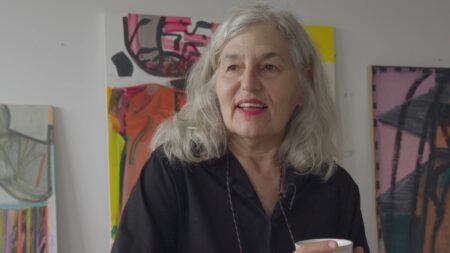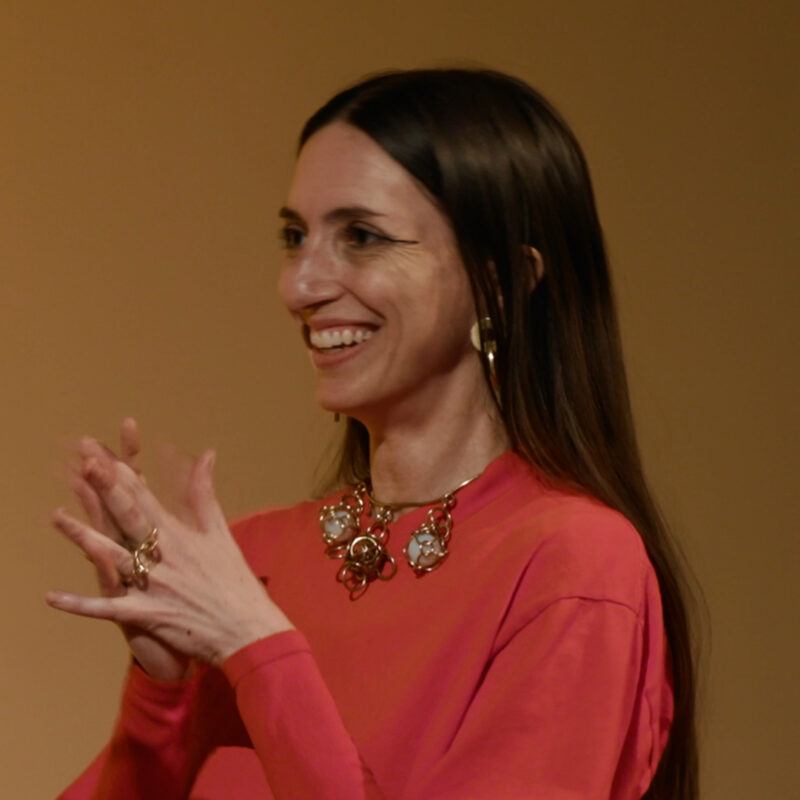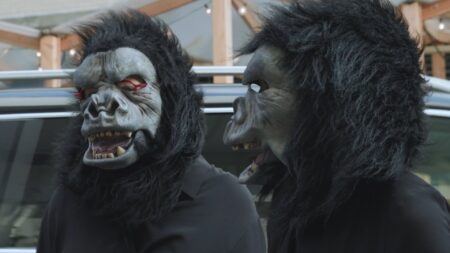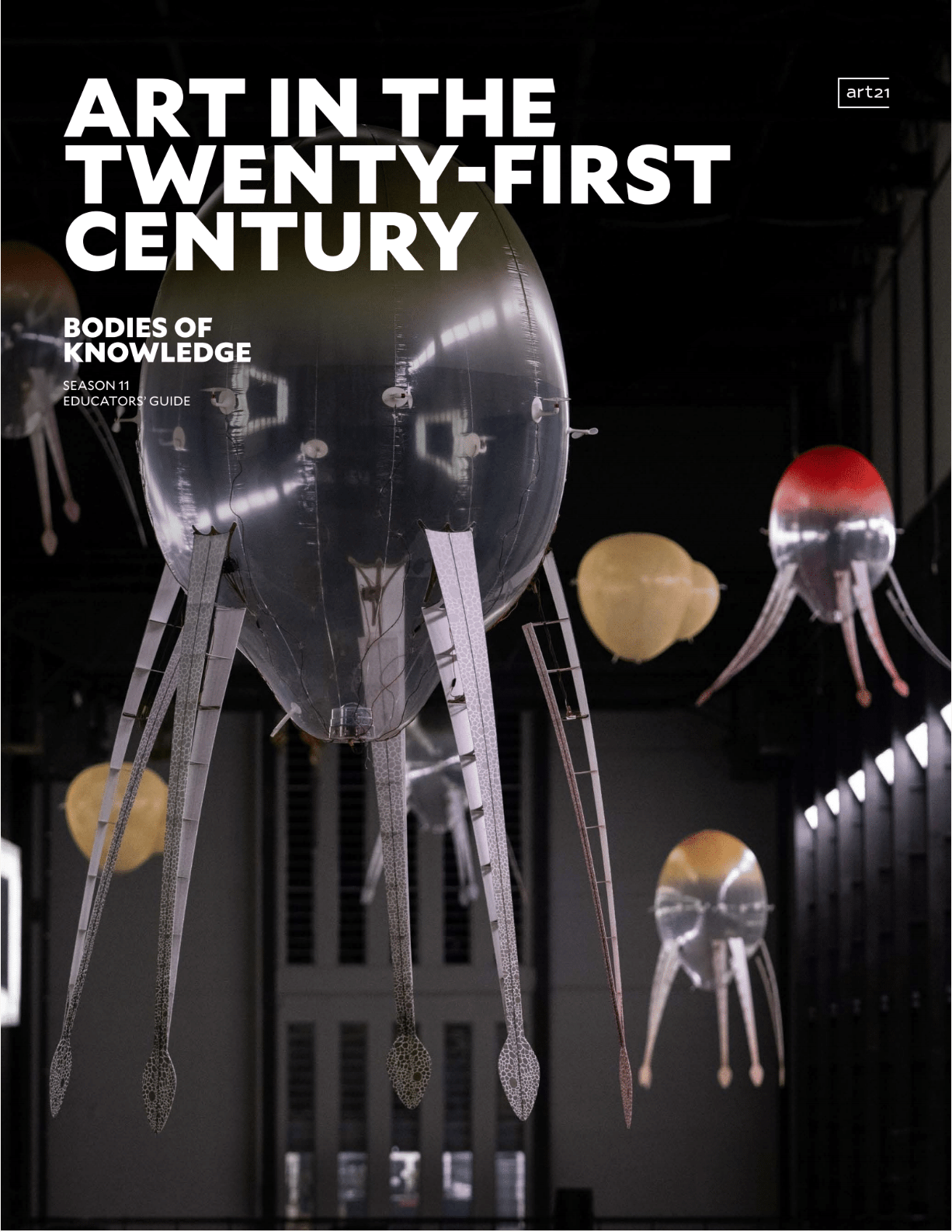Continue playing
(Time remaining: )
Play from beginning
Continue playing "{{ controller.videos[controller.getVideo(controller.currentVideo)].segmentParentTitle}}"
{{controller.videos[controller.getVideo(controller.currentVideo)].title}} has ended.
Tauba Auerbach in “Bodies of Knowledge”
Descriptive audio version available here.
Visit our Awards page for this film’s honors and recognition.
In their Brooklyn studio, artist Tauba Auerbach uses craft traditions as research methods to deepen their understanding of mathematical and scientific theories. “It seems appropriate to me to work in a lot of different materials, media, and processes, because I’m focusing on connectivity and the relationship between lots of different things,” says Auerbach. As an apprentice at New Bohemia Signs in San Francisco, Auerbach learned to approach painting as a technology, requiring precision and balance to achieve what they call a “sweet spot.” Auerbach frequently merges painting with other techniques to create eye-catching murals and designs, using the floating dyes from a paper marbling tray as the source for their 2019 mural 2020 on the Mosser Towers; their “dazzle pattern” in Flow Separation (2018), painted on New York’s John J. Harvey Fireboat; and their handpainted mural inside the San Francisco Museum of Modern Art (SFMOMA), as part of their 2022 survey exhibition S v Z.
One of the works in S v Z is Auerglass Organ (2009), which draws inspiration from Wave Organ, another piece that sits just north of SFMOMA. Wave Organ is a 1986 work by Peter Richards and George Gonzales that activates the unstable relationship between land and sea using a series of pipes that descend from a jetty into the ocean at varying heights, producing sound as the tides change. Interdependence and instability are also characteristics of Auerglass Organ, the two-person, interdependent pump organ the artist designed with musician Cameron Mesirow, who performs as Glasser. The instrument requires cooperation to work, with a four-octave keyboard divided between either side of the organ in alternating notes, and pedals beneath each player’s feet that pump air to give voice to the other player’s notes. With Mesirow seated opposite the artist, the pair practice and perform what Auerbach calls a nearly impossible task, two performers playing as one.
Back in their studio, Auerbach drags a chisel tip marker across gridded paper to make their Ligature Drawings. The ligature drawings use a “knit structure,” sequences of a single gesture woven together on the page, wherein the artist challenges themselves, modifying the rules of a sequence without lifting the marker, or attempting to draw from a specific part of the body like the wrist or the elbow. The trance-like state achieved in these intuitive and spontaneous drawings is the ideal space for the artist to think, and thus constitutes a kind of research technology in itself. “There is so much wisdom embedded in techniques and procedures for crafts passed from person to person,” says Auerbach, whose practice continues to evolve using the body as a tool for thought.
More information and creditsCredits
Executive Producer: Tina Kukielski. Series Producer: Nick Ravich. Director: Malika Zouhali-Worrall. Producer: Danielle Varga. Editor: Steven J. Golliday. Director of Photography: Naiti Gámez. Assistant Curator: Jurrell Lewis. Associate Producer: Andrea Chung. Design & Animation: Ryan Carl, Nikita Iziev. Composer: Andrew Orkin.
Additional Photography: Julia Liu, Jenni Morello, Mattia Ramberti, Brianna Wray. Assistant Camera: George Alvarez, Javier Castillo, Allen Dobbins, Sarah Jaffe, Todd Leatherman. Location Sound: Jim Choi, La’Ron Cooper, Damon Karys, Alberto Ladduca, Lily van Leeuwen, Taylor Roy, Emily Strong, Tommaso Zerbini. Field Producer: Ursula Liang. Production Coordinators: Sasha Leitmann, Arjun Pothuri. Production Assistants: Connor Finn, Kabir Kumar-Hardy, Quan Robinson, Gordon Taylor, Mishel Valle-Ayala. Art Handlers: Robert Guynn, Chris Rogy.
Advising Proder: Ian Forster. Video Post-Production Services: Cut + Measure. Video Post-Production Producer: Alex Laviola. Colorist: Chris Ramey. Online & Conform: David Gauff. Additional Video Editor: Addison Post. Post-Production Coordinator: Leah Ford. Additional Animation: Andy Cahill, Yasmin Mistry. Audio Post-Production Sound Services: Konsonant Post. Re-Recording Mixers: Gisela Fullà-Silvestre, Ben Kruse. Sound Editor: Ben Kruse. Assistant Editors: Ellen Askey, Stephanie Cen, Michelle Hanks. Station Relations De Shields Associates. Legal Counsel: Withersworldwide. Additional Curatorial Research: Susan Thompson.
Additional Art21 Staff: Lauren Barnett, Hannah DeGarmo, Lolita Fierro, Joe Fusaro, Molaundo Jones, Emma Nordin, Anna Pruett, Jessica Svenson, Noor Tamari, Nora Wimmer. Interns: Stephanie Ades, Sekou Cherif, Yeon Cho, Michaela Esteban, Emma Flood, Amber He, Carina Martinez, Renee Rienecker, James Santiago, Adam Varca, Dani Wieder.
Artwork Courtesy: Tauba Auerbach, Guerrilla Girls, Hank Willis Thomas, Anicka Yi, Paula Cooper Gallery, Jack Shainman Gallery, Gladstone Gallery, Anicka Yi, “Metaspore” at Pirelli HangarBicocca, Milan, 2022.
Archival Materials: Kelvin Adjei-Akosah, Agence France-Presse, Associated Press
Bettmann, Lance Brewer, David Briddell, Ron Cogswell, David M. Rubenstein Rare Book & Manuscript Library, Duke University; Embrace Boston, Equal Justice Initiative , Estate of Ernest Cole, Getty Images, Great Voices of Bulgaria, The Guardian, Amy Harrison, Human Pictures, Hulton Archive, Library of Congress, Magnum Photos, MASS Design Group, The New Press, Steven Probert, Public Art Fund, SandenWolff, San Francisco Museum of Modern Art, Jon Santos, Katja Schulz, Davina Semo, Ted Shaffrey, Skyhorse Publishing, Clarissa Sligh, Damon Styer, Tate Modern, Temple University Press, Time Inc, TV1 Broadcast Company, Bulgaria; Richard Vogel, W. W. Norton & Company.
Interviewees: Cleo Berliner, Esther Chao, Jonathan Evans, Coco Fusco, Sam Giarratani, Jasmine Guzman, Rujeko Hockley, Emily Majors, Muna Malik, Cameron Mesirow, Roberto Morales, Frances Morris, Sriranjini Raman, Samhita Ramji, Juan Rojero, Will Sylvester, Jawaid Toppa, Dr. Deborah Willis.
Special Thanks: The Art21 Board of Trustees, Xabier Arakistain, John Felix Arnold, Art Gallery of Ontario, Joseph Becker, Bert Bergen, Olivia Berke, Alessandro Bianchi, Sanford Biggers, The Boston Foundation, Alessandro Cane, Christina Caputo, Yu Rim Chung, Collection of the City of Boston, Allison Cooper, Christian Dioulo, Folasade Falebita, Jenny Gheith, Goodman Gallery, South Africa, Andy Greenberg, Remina Greenfield, Fiammetta Griccioli, Clara Hatcher Baruth, Imari Jeffries, Thomas Kelley, Rob Massey, Stacee Prigmore Monroe, National Memorial for Peace and Justice, A. Joaquin Navas, Negative Space, Devan Owens, Fernando Ramirez, Erik Savercool, Melissa Shakun, Hana Tran, Saulius Valaitis, Walla Walla Foundry, The Wave Organ, Maria Wiles, Family of Hank Willis Thomas.
Major underwriting for Season 11 of Art in the Twenty-First Century is provided by PBS, National Endowment for the Arts, Lambent Foundation, The Anna-Maria and Stephen Kellen Foundation, The Andy Warhol Foundation for the Visual Arts, The Horace W. Goldsmith Foundation, Toby Devan Lewis, Robert Lehman Foundation, and Nion McEvoy & Leslie Berriman.
Series Creators: Susan Dowling and Susan Sollins.
©2023 Art21, Inc.
Closed captionsAvailable in English, German, Romanian, Italian, Japanese, Korean, Chinese, Italian
Through the Art21 Translation Project, multilingual audiences from around the globe can contribute translations, making Art21 films more accessible worldwide. Translate this video now.
Interested in showing this film in an exhibition or public screening? To license this video please visit Licensing & Reproduction.
Tauba Auerbach was born in 1981 in San Francisco, California, and currently lives and works in New York City. The artist received a BA in Visual Studies from Stanford University in 2003. Interested in the relationships between materials, ideas, and people, Auerbach examines connective tissues and structures using a wide variety of materials and processes. Their practice weaves bodily craft traditions with abstract theory to create drawings, paintings, sculptures, and more that expand our comprehension of how the world is structured and connected.
“I’m interested in the edges of where a system coheres and where it starts to fray and come apart, and also where the edges of our understanding and comprehension fray and start to come apart.”
Tauba Auerbach





